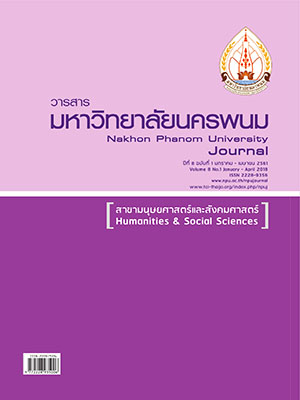การเปลี่ยนแปลงของวงซายวายในสาธารณรัฐแห่งสหภาพเมียนมา
Main Article Content
Abstract
The objectives of this study were to investigate: 1) the changes of musical instruments of Saing Waing Ensemble in the Republic of Union of Myanmar, 2) the changes of roles of Saing Waing Ensemble in rituals and performances. Field data were collected from observations and interviews with knowledgeable individuals, practitioners, and general persons involved with Saing Waing Ensemble in Mandalay, Republic of Union of Myanmar. Data were analyzed according to the given objectives and the findings of study were presented with descriptive analysis.
Findings of the study were as follows: 1) regarding to the musical instruments of Saing Waing Ensemble. There were changes in physical characters. Tones were added in Pat Waing, Kyei Waing, Maung Saing; and a number of Si Do drums were added from 1-2 to 4-7 drums. These were done to improve the efficiency of Saing Waing performances. 2) Regarding to the roles of Saing Waing Ensemble in rituals and performances. In the past, Saing Waing Ensemble was used in royal rites. But after the end of the absolute monarchy, the Saing Waing Ensemble that performed the royal rites was no longer visible. Walking Saing Waing Ensemble in royal procession became a procession in village oxcarts or cars. At present, electric keyboards are brought to play the melody of songs instead of the Pat Waing drums in the procession; and Western musical instruments are brought to play together with the Saing Waing Ensemble. Concerning the changes of roles in Saing Waing Ensemble’s playing as an accompaniment of the performances for the general public, Western bands and tunes were joined to play along with the Saing Waing Ensemble, such as in “Zat Pwe and Angeint performances, to attract the attention of the audience. As for the Yoke-thay Pwe performance, there has been a change from a performance at the past royal court to one in the theater to welcome tourists. The duration of show is changed into a shorter time, and the traditional Saing Waing Ensemble is still in use just like the one in the past.
Article Details
References
เฉลิมศักดิ์ พิกุลศรี. (2551). ดนตรีลาวเดิม. ขอนแก่น : ศูนย์วิจัยพหุลักษณ์สังคมลุ่มน้ำโขง, มหาวิทยาลัยขอนแก่น.
มองซิเออร์ เดอร์ ลาลูแบร์. (2552). จดหมายเหตุ ลา ลูแบร์ ราชอาณาจักรสยาม. พิมพ์ครั้งที่ 3. แปลโดย สันต์ ท. โกมลบุตร. นนทบุรี : ศรีปัญญา
วิรัช นิยมธรรมและอรนุช นิยมธรรม. (2551). เรียนรู้สังคมวัฒนธรรมพม่า. พิษณุโลก : โรงพิมพ์ตระกูลไทย.
สำเริง ปานดิษฐ์. (2560). ดนตรีพม่าในการแสดงพระธรรมเทศนา: กรณีศึกษาวงซายวายคณะเซ่ยเมี๊ยะโจว วัดไทยวัฒนาราม ตำบลท่าสายลวด อำเภอแม่สอด จังหวัดตาก. วารสารมหาวิทยาลัยนครพนม, 7(2), 99-107.
Department of Art, Ministry of culture. (1998). Ancient Myanmar music instruments (In Myanmar). Myanmar : Ministry of culture.
Garifas, R. (1985). The development of modern Burmese Hsaing Ensemble. Asian Music, 16(1), 1–28.
Gibbs, J., Harnish, D., Miller, E. T., Murray, D., Sooi, B. T. & Kit, Y. (2013). Longing for the past. Atlanta : Dust-To-Digital Longing For The Past.
Naing, Y. K. (2014). The art of Myanmar traditional puppetry Ma Ma Naing (Mandalay Marionettes). Yangon : Mann Chaung Publishing.
Khin, Z. (2006). Myanmar culture. Yangon : Today Publishing House Ltd.
U Learn Publishing house. (n.d.). Myanmar Saing Waing. Yangon : U Learn Publishing house.
Ye, D. (2014). Myanmar dance and drama. Yangon : Today Publishing House Ltd.


